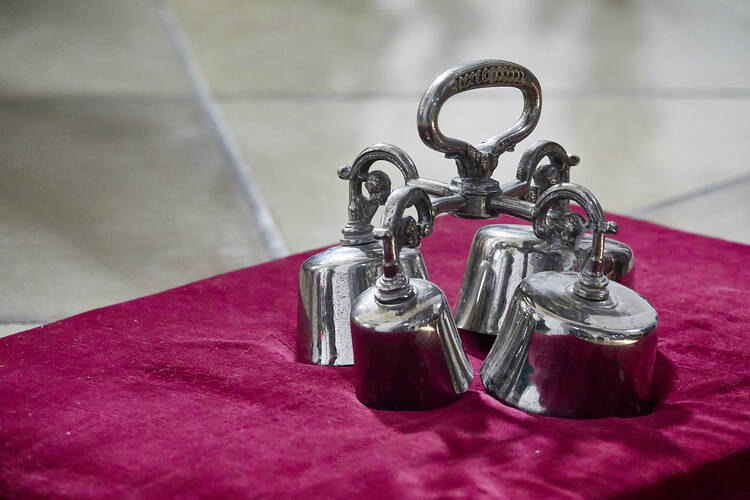The ringing of the brass altar bells was one of my favorite moments when I was an altar boy, and also in my experience of the Mass to this day. At Immaculate Heart of Mary Catholic Church in Lafayette, La., the church of my upbringing, we altar boys rang the embossed brass bells during the consecration—that ceremonial moment of our faith in which the priest declares the bread and wine to be the body and blood of Christ. The ringing of the bells orients me to the faith practice of my childhood.
For me, ringing the bells was always a performative act with words that made real, through faith, the transformation of bread and wine into the body and blood of Christ. The act is called transubstantiation and is brought about in the eucharistic prayer through the efficacy of the word of Christ and by the action of the Holy Spirit. The bells I rang as an altar server signaled the congregation to pay attention; to prepare to receive Communion.
Ringing the bells was always a performative act with words that made real the transubstantiation of the bread and wine.
The bells were rung at three critical moments. The first was at the epiclesis, “the invocation of the active presence of the Holy Spirit in the eucharistic prayer so that the bread and wine may become the body and blood of Christ.” This is the point in the Mass when the presider at the Eucharist extends his hands over the gifts and says, “Lord, send down your Spirit....”
The bells are rung again just after the consecration of the bread, when the priest says: “Take this all of you and eat of it. For this is my body which will be given up for you,” after which he elevates the host.
The sound of the multiple clappers within the bell is forever a part of me as a moment of reverence.
The bells are rung again just after the priest consecrates the wine, saying, “Take this all of you and drink from it. For this is the chalice of my blood. The blood of the new and eternal covenant, which will be poured out for you and for all, for the forgiveness of sin. Do this in memory of me.”
I remember my training for using the altar bells: kneeling posture, wrist action, ringing and silencing. The sounding of the bells by the altar boys does not merely signal the transubstantiation, it is a device to activate the congregation in reflecting and focusing on what is taking place right before them. It is, in a way, a centering device, the re-sounding reminder of our faith, that bread and wine really is turned into the body and blood of Christ. As a young altar boy it was the same—a trigger of faith and remembrance.
The sound of the multiple clappers within the bell that swing and collide inside to make the bell ring, that move independently, but in yoked tandem with the cluster of three or four bells, is forever a part of me as a moment of reverence.
The bells are a device to activate the congregation in reflecting and focusing on the consecration.
But as public as the act of ringing the bell was, it always seemed so private to me (then and now; I am sure the sound resonates similarly and differently in all who heard it.) I took the act seriously. And as an altar boy it told me that I had a role to play in the faith practices of my community that still resonates in me today.
The bells made a tinkling and chiming sound that is written into the memory and script of my worship. So much so, that after all these years, in Mass services that no longer use the bells in this ritualistic way, my memory fills in the space of silence during the Mass. Even in their absence, I hear the bells ringing in those moments. And from time to time I feel the phantom gesture of my hand gently but vigorously ringing the bells as an altar boy nearly a lifetime ago. I feel the vibrations of the bells as they move up through my hand and wrist, and maybe through my very soul. I remember that ringing, hearing and feeling as something distinct and real that still lives in me.
From time to time I feel the phantom gesture of my hand gently but vigorously ringing the bells.
Several years ago, I developed a type of ofrendas, an altar of photographs to remember both the living and the dead of my family in my home office. I sometimes adorned it with flowers, palm fronds, trinkets and even Louisiana herbs and spices. But there was always something missing.
I felt that the missing piece, separate from candles and a cross, was one of those handheld brass altar bells. So I found one and placed it among the images of my family. Periodically, on holy days of obligation, birthdays, anniversaries, and on those days when the souls of my family are too-present with me—I ring the bells and light the candles. I welcome the spirits of my family more fully into my home through prayer. I express my love for them, and sometimes beg their forgiveness. I beg forgiveness for the times when I have failed to be better, to do better as the good Catholic boy my mother wanted me to be. This simple act of worship and remembrance helps.








